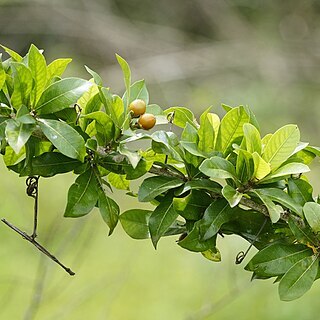Indumentum present at least on calyx. Stipules palmatifid-laciniate, pinnati-lobed or simple, entire or dentate. Leaves spirally arranged. Flowers in axillary or terminal more or less densely flowered racemes or leafy or leafless panicles, or axillary, in few-flowered cymes or solitary, rarely ramiflorous. Bracts and bracteoles present or not. Sepals free, unequal, rarely subequal. Petals shortly clawed or thickened at base. Nectary glands present or not. Ovary 5(-6)-loculed; styles 5(-6). Drupe (pseudo-)indehiscent or splitting into 5 pyrenes; endocarp woody, provided with more or less prominent longitudinal ribs, either compact and forming one stone with 5(-6) fertile locules alternating with as many interlocular sterile cavities or divided into 5 thin, more or less obviously ribbed pyrenes which are separated by a fleshy mesocarp. Seeds 1 per locule, 2-4(-5) developed per fruit, apically attached. Embryo with fleshy endosperm.
Woody lianes, sometimes shrubs or trees. Leaves alternate, entire to crenate; stipules entire, with glandular teeth or reduced to glands. Inflorescences axillary or terminal racemes or panicles. Sepals free or connate at base. Petals clawed. Nectary glands 5, adnate to staminal tube or (not in Australia) absent. Stamens 10, long alternating with short. Ovary usually 5-locular. Fruit ± fleshy, splitting into usually 5 pyrenes or (not in Australia) not fragmenting. Seeds 1 per pyrene, ± elliptic, compressed; endosperm copious.
Leaves petiolate, alternate, entire or with a crenulate to serrate or dentate margin, penninerved, sometimes with domatia in the nerve axils and with ± densely reticulate tertiary venation; stipules pinnatifid or palmatifid, often caducous.
Flowers solitary or in pairs or few-flowered cymes in the leaf-axils, more rarely in condensed terminal bracteate cymes, (always?) trimorphically heterostylic.
Ovary with 2–5 fertile loculi alternating with an equal number of sterile loculi; styles 2–5, free or rarely partially united; stigmas capitate, grooved.
Fruit a drupe with 3–5 or fewer seeds (not more than one per originally fertile loculus), with the hard endocarp vertically grooved.
Petals 5, usually yellow, darker at the base, shortly and narrowly unguiculate with the claw inserted on the dorsal side, free.
Trees, shrubs (rarely shrublets), or lianes climbing by recurved tendrils (usually in subopposite pairs).
Stamens 5 + 5, all fertile, with filaments united at the base to form a cup.
Seeds smooth, flattened, endospermic; embryo straight or slightly curved.
Sepals 5, quincuncial, usually unequal, entire, free, persistent.

